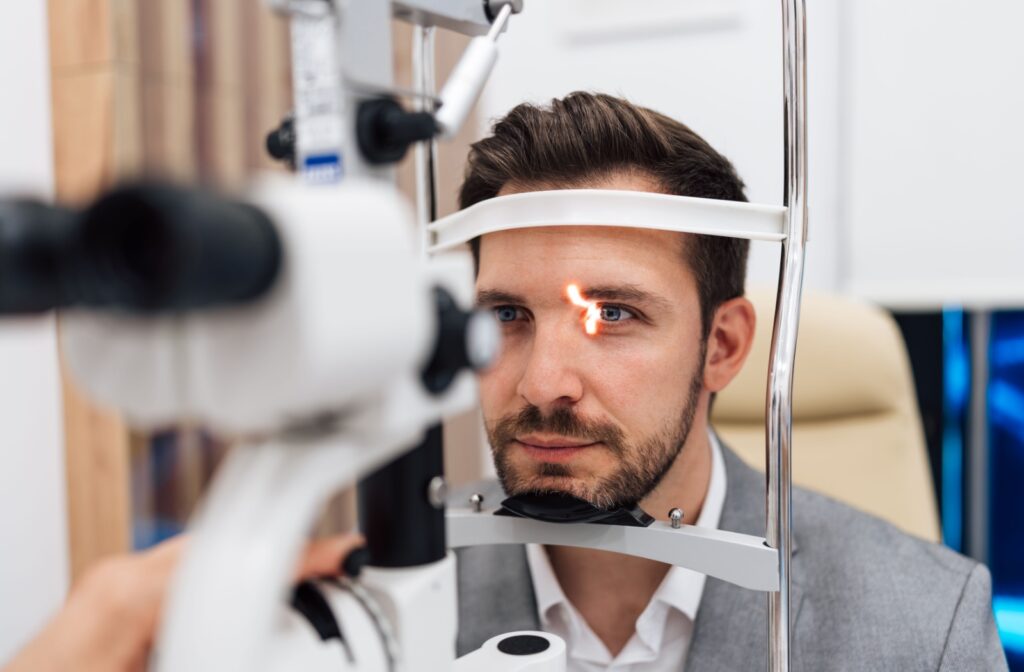An eye exam does more than measure vision and prescribe corrective lenses; it can also reveal clues about a person’s general health. In particular, certain findings during an eye exam may point toward diabetes, sometimes even before the condition has been diagnosed. This connection comes from the unique view eye care professionals have of the blood vessels inside the eye, which can reflect what is happening throughout the body.
How the Eye Reflects Overall Health
The retina, the light-sensitive layer at the back of the eye, contains a dense network of tiny blood vessels. Because these vessels are directly visible during an eye exam, they can show signs of damage from chronic conditions, including diabetes.
When blood sugar levels remain elevated over time, the vessel walls may become weakened or damaged. This can lead to microaneurysms, tiny leaks, or blockages that disrupt blood flow. If fluid or blood leaks into the retina, it may cause swelling or areas of reduced oxygen supply. These early changes can be detected before the person notices any change in vision.
The Link Between Diabetes & Eye Disease
Diabetes can lead to several eye conditions, the most common being diabetic retinopathy. This occurs when high blood sugar levels damage retinal blood vessels, causing them to leak or close off. Over time, new, fragile vessels may grow, which are prone to bleeding. Other complications can include diabetic macular edema, which involves swelling in the central retina, and an increased risk of glaucoma or cataracts.
Detecting these changes early can help protect vision and prompt timely medical follow-up. This is why comprehensive eye exams are an important part of overall health care, especially for those with risk factors for diabetes.
What Happens During an Eye Exam
Several techniques used during an eye exam help detect signs that may be linked to diabetes.
Pupil Dilation
Eye drops are used to widen the pupils, allowing a clearer view of the retina and optic nerve. This step makes it easier to see small vessel changes, swelling, or bleeding that might otherwise be missed.
Retinal Imaging
High-resolution imaging, such as fundus photography or optical coherence tomography (OCT), captures detailed pictures of the retina. These images can reveal:
- Leaking or damaged blood vessels
- Fluid accumulation in retinal layers
- Structural changes in the macula or surrounding tissues
Because these records are stored, they can also be compared over time to track any changes.
Fundoscopy
Using a special instrument, the eye care professional examines the back of the eye, including areas in the retinal periphery. Sometimes, the earliest signs of diabetic changes appear outside the central retina, making this step valuable.
Why Early Detection Matters
In its earliest stages, diabetic retinopathy often causes no noticeable symptoms. By the time vision becomes blurred or distorted, significant damage may have already occurred. Regular eye exams offer a chance to spot these issues sooner, which can support treatment efforts and help prevent progression.
Even for people without a diabetes diagnosis, an eye exam may reveal changes that prompt further medical testing. In such cases, an eye care provider may recommend visiting a primary care physician or endocrinologist for a blood sugar check and other assessments.
Subtle Vision Changes That May Prompt an Exam
While not always present, certain vision changes may lead someone to schedule an eye exam, including:
- Blurry or fluctuating vision.
- Sudden changes in prescription strength.
- Mild spots or dark areas in vision.
These symptoms can be related to various conditions, but they may also appear in people with undiagnosed diabetes.
Follow-Up & Ongoing Care

If diabetic changes are noted in the eye, follow-up care usually involves two steps: continued eye monitoring and coordination with medical providers. Annual or more frequent diabetic eye exams may be recommended, depending on the severity of findings.
Medical management may include changes to diet, activity levels, or medications to help control blood sugar. In eye disease that is more progressed, treatments might involve laser therapy, injections, or surgery to preserve vision.
Common Retinal Signs Linked to Diabetes
Eye care professionals may look for several patterns during an exam that could indicate diabetes:
- Microaneurysms (tiny bulges in blood vessel walls).
- Small retinal hemorrhages or bleeding.
- Cotton-wool spots, which are areas of nerve fiber damage.
- Macular swelling.
- New, abnormal vessel growth.
Looking at the Bigger Picture
Detecting signs of diabetes in an eye exam is only part of the story. What follows is just as important; connecting eye health with overall wellness. This might involve conversations about lifestyle, risk factors, and the importance of regular monitoring.
At Discover Eyecare in Abbotsford and Chilliwack, we use advanced retinal imaging to catch early signs of diabetes before they affect your vision. Our team is here to guide you with clear answers, proactive care, and a personalized plan for your eye and overall health.
Book your comprehensive eye exam today.



